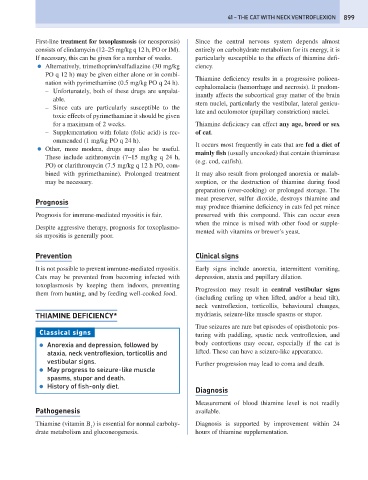Page 907 - Problem-Based Feline Medicine
P. 907
41 – THE CAT WITH NECK VENTROFLEXION 899
First-line treatment for toxoplasmosis (or neosporosis) Since the central nervous system depends almost
consists of clindamycin (12–25 mg/kg q 12 h, PO or IM). entirely on carbohydrate metabolism for its energy, it is
If necessary, this can be given for a number of weeks. particularly susceptible to the effects of thiamine defi-
● Alternatively, trimethoprim/sulfadiazine (30 mg/kg ciency.
PO q 12 h) may be given either alone or in combi-
Thiamine deficiency results in a progressive polioen-
nation with pyrimethamine (0.5 mg/kg PO q 24 h).
cephalomalacia (hemorrhage and necrosis). It predom-
– Unfortunately, both of these drugs are unpalat-
inantly affects the subcortical gray matter of the brain
able.
stem nuclei, particularly the vestibular, lateral genicu-
– Since cats are particularly susceptible to the
late and oculomotor (pupillary constriction) nuclei.
toxic effects of pyrimethamine it should be given
for a maximum of 2 weeks. Thiamine deficiency can effect any age, breed or sex
– Supplementation with folate (folic acid) is rec- of cat.
ommended (1 mg/kg PO q 24 h).
It occurs most frequently in cats that are fed a diet of
● Other, more modern, drugs may also be useful.
mainly fish (usually uncooked) that contain thiaminase
These include azithromycin (7–15 mg/kg q 24 h,
(e.g. cod, catfish).
PO) or clarithromycin (7.5 mg/kg q 12 h PO, com-
bined with pyrimethamine). Prolonged treatment It may also result from prolonged anorexia or malab-
may be necessary. sorption, or the destruction of thiamine during food
preparation (over-cooking) or prolonged storage. The
meat preserver, sulfur dioxide, destroys thiamine and
Prognosis
may produce thiamine deficiency in cats fed pet mince
Prognosis for immune-mediated myositis is fair. preserved with this compound. This can occur even
when the mince is mixed with other food or supple-
Despite aggressive therapy, prognosis for toxoplasmo-
mented with vitamins or brewer’s yeast.
sis myositis is generally poor.
Prevention Clinical signs
It is not possible to prevent immune-mediated myositis. Early signs include anorexia, intermittent vomiting,
Cats may be prevented from becoming infected with depression, ataxia and pupillary dilation.
toxoplasmosis by keeping them indoors, preventing
Progression may result in central vestibular signs
them from hunting, and by feeding well-cooked food.
(including curling up when lifted, and/or a head tilt),
neck ventroflexion, torticollis, behavioural changes,
THIAMINE DEFICIENCY* mydriasis, seizure-like muscle spasms or stupor.
True seizures are rare but episodes of opisthotonic pos-
Classical signs turing with paddling, spastic neck ventroflexion, and
● Anorexia and depression, followed by body contortions may occur, especially if the cat is
ataxia, neck ventroflexion, torticollis and lifted. These can have a seizure-like appearance.
vestibular signs. Further progression may lead to coma and death.
● May progress to seizure-like muscle
spasms, stupor and death.
● History of fish-only diet.
Diagnosis
Measurement of blood thiamine level is not readily
Pathogenesis available.
Thiamine (vitamin B ) is essential for normal carbohy- Diagnosis is supported by improvement within 24
1
drate metabolism and gluconeogenesis. hours of thiamine supplementation.

